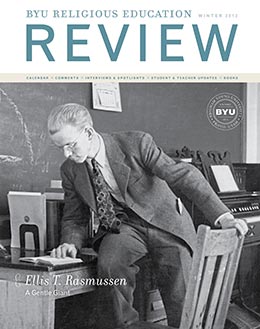Kenneth L. Alford (ken_alford@byu.edu) is an associate professor of Church history and doctrine at BYU.
How many Latter-day Saints served in the Union and Confederate military forces during the American Civil War, and who were they? Surprisingly, the answers have remained elusive.
In the 150 years that have passed since the beginning of the Civil War, no thorough research for Latter-day Saint Civil War veterans has been published. That is about to change, though, thanks to research made possible by donations to BYU Religious Education. In the second quarter of 2012, the Religious Studies Center at BYU will publish Civil War Saints—a book that takes a close look at Latter-day Saints and Utah Territory during the war and includes a large appendix listing Latter-day Saint Civil War veterans (with vital records, baptism, Civil War service, notes, and source information for each LDS veteran).
Identifying someone as a “Civil War veteran” required different definitions for Union and Confederate veterans. Union veterans must have active federal service (service that qualified for federal pension benefits) between January 9, 1861 (when Confederate artillery opened fire on the Star of the West in Charleston Harbor, South Carolina) and June 23, 1865 (the date that General Stand Watie surrendered the last Confederate soldiers in the Indian Territory). This definition is similar to that used by the Grand Army of the Republic (GAR) to qualify applicants for membership. Applying this definition to Utah Territory means that Lot Smith’s Utah Cavalry soldiers are considered Civil War veterans—their ninety-day active-duty service in 1862 was accepted for pension and GAR membership purposes. On the other hand, members of the Nauvoo Legion (Utah’s militia) are not considered Civil War veterans as their service did not qualify for federal pensions or GAR membership. Any service member who fought for the Confederacy is considered a Civil War veteran; there was no active duty versus militia distinction for Confederate military service.
A Latter-day Saint, for the purposes of this research, is defined as anyone baptized as a member of The Church of Jesus Christ of Latter-day Saints prior to, during, as well as after the Civil War and includes individuals who were excommunicated. (It does not, of course, include individuals baptized vicariously.) For example, William Smith, younger brother of the Prophet Joseph Smith (who was baptized June 9, 1830, and served during the Civil War in Company G, 126th Illinois Infantry), is included, even though he was excommunicated after his brother’s death.
A major reason why no thorough Latter-day Saint Civil War veterans list has been previously published is because the resources to find and document LDS Church membership and Civil War veteran status have been largely unavailable or were difficult to examine. The recent proliferation of Internet databases related to both LDS Church membership and Civil War veterans has enabled this research.
The majority of day-to-day digging, searching, comparing, and rechecking was completed by a group of enthusiastic student researchers who have spent hundreds of hours in pursuit of this information. Their help, made possible by donor funds, has been invaluable.
While there are exceptions, here is the basic process used to add individuals to the Latter-day Saint Civil War veterans list:
- Identify a possible LDS Civil War veteran. A variety of resources were used: online databases, newspaper obituaries, biographies, and even tips from contributors.
- Confirm that the individual was baptized as a Latter-day Saint. Most baptisms were confirmed through the Church’s New Family Search family history website, but additional resources were checked.
- Confirm that the individual qualified as a Union or Confederate veteran. The National Park Service’s Civil War Soldiers and Sailor System database was most helpful, but it is incomplete. We also used federal pension records and a host of other methods.
- Work to confirm that the LDS member and the veteran identified were the same individual. This step was often the most difficult.
We have identified several hundred Latter-day Saint Civil War veterans. Most fought for the Union. Many fought for the Confederacy, and a select few (called “galvanized Yankees”) actually fought for both sides—first for the Confederacy and then for the Union. We are pleased to recognize the military contributions of those Latter-day Saints. Civil War Saints will share many of their stories as well as new research regarding the Civil War legacy from the Utah War, Abraham Lincoln and the Mormons, D&C 87, wartime LDS emigration, the establishment of Camp Douglas, how Civil War newspapers viewed Mormonism, Utah’s native Americans, Lot Smith’s Utah cavalry company, the Nauvoo Legion, Latter-day Saints and the war’s aftermath, and Utah and the GAR.
